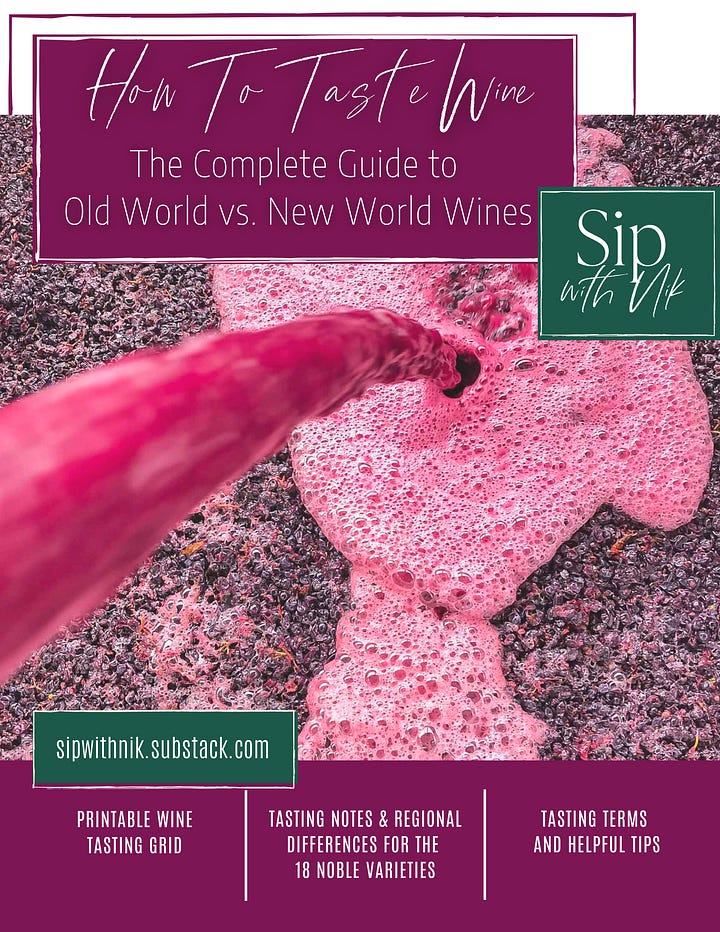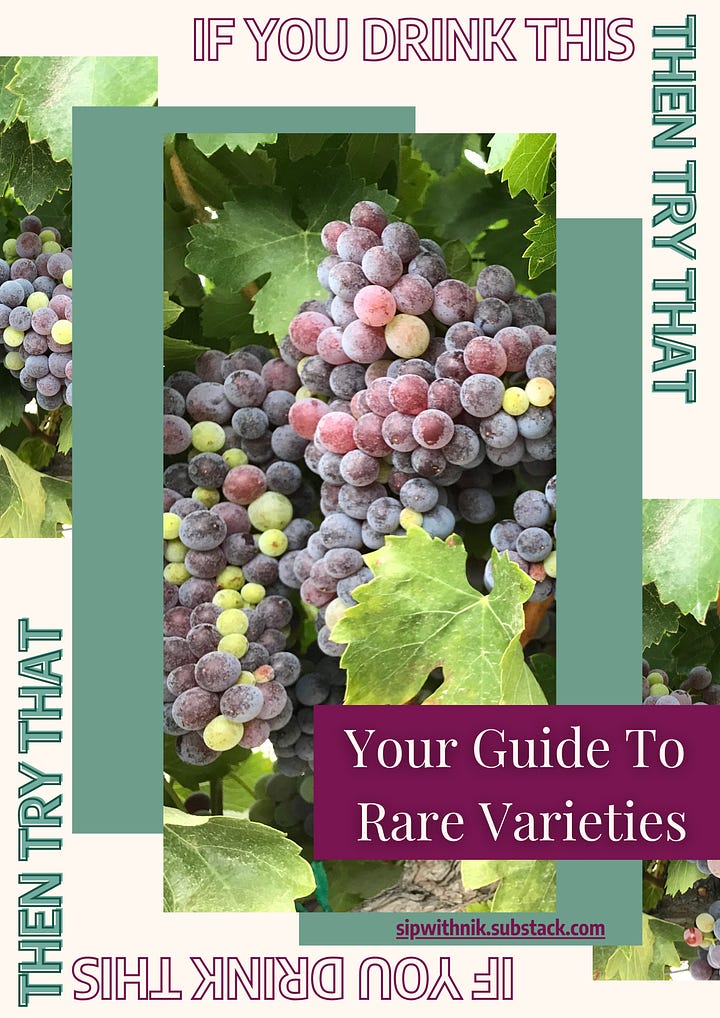Exploring Croatia's Hidden Gem Wines: 7 Indigenous Varieties to Try This January
Plus a recipe for longevity from Sardinia and a new addition to Sip with Nik for paid subscribers.
In October 2017, I visited Croatia and fell in love with its enchanting views of the Adriatic Sea, delicious local cuisine, and warm hospitality. However, the greatest revelation of my trip was Croatian wine.
The quality of Croatian wine has since continued to amaze me. If you have yet to explore Croatian wines, then Try January is the perfect opportunity to do so!
A New Addition for Paid Subscribers
Before we dive into these wonderful wines, I wanted to let you know about a new addition to Sip with Nik for paid subscribers: a library of Food & Wine Guides!
Explore the art of perfect pairings and deepen your wine knowledge with this collection of helpful guides:
Where To Go Wine Tasting in Sardinia
The Ultimate Guide to Wine & Cheese Pairing
How to Taste Wine: The Complete Guide to Old World vs. New World Wines
BBQ Wine Pairing Guide
Herb & Wine Pairing Guide
If You Drink This, Then Try That: Your Guide to Rare Varieties
Fall Food & Wine Pairing Guide with Recipes
Holiday Recipes & Wine Pairings







Now, here are 7 Croatian varieties worth discovering and wine pairing recommendations to match.
Pošip: A Captivating Croatian Variety from Korčula
On our first day in Dubrovnik all those years ago, my friends and I popped into a bar and bought a bottle of Pošip, a white Croatian wine. Although we intended to save it, a sudden rainstorm led us to finish it in one sitting at that cozy bar. We left happier than we arrived with Pošip’s flavors lingering on our minds.
The Variety: Pošip
Pošip is a white grape indigenous to the island of Korčula, discovered growing wild in 1864. A local farmer, intrigued by its flavor, cultivated it, and the rest is history. Researchers later traced its lineage to two native varieties: Bratkovina Bijela and Zlatarska Bistrica.
Wine has been integral to Korčula’s culture since ancient Greek times. The villages of Smokvica and Čara are Pošip’s birthplace and produce its finest expressions. Although originally cultivated on Korčula, Pošip is now grown throughout Dalmatia, including the Pelješac peninsula and islands like Brač and Hvar.
Remarkably, Pošip resisted the phylloxera epidemic due to the sandy soils of Smokvica. Before phylloxera, Korčula had 4,000 hectares of vineyards, mostly red varieties. Today, only 450 hectares remain, with white varieties—dominated by Pošip—making up 70%.
Pošip in the Glass
The best Pošip wines are full-bodied, well-balanced, and golden yellow in color. Expect aromas of dried Mediterranean herbs, apricots, citrus, and pine.
While traditionally a sweet dessert wine, Pošip is now mostly produced in a dry style, with both oaked and unoaked versions available. It was Croatia’s first white wine designated as premium quality and received a controlled designation of origin in 1967.
Pošip in the Vineyard
Pošip is a high-yielding, early-ripening variety capable of producing high-quality fruit when managed well. It achieves high sugars while maintaining acidity, making it adaptable across Dalmatia.
In Korčula, Pošip thrives in rich, sandy soils under sunny Mediterranean skies. Around Smokvica, vineyards are terraced into rocky hillsides and benefit from freshwater streams. However, coastal winds, humidity, and sunburn can challenge the thin-skinned grapes, requiring careful canopy management.
Winery Highlight: Toreta
Toreta, a family-owned winery in Smokvica, specializes in Korčula’s indigenous varieties.
Toreta Pošip Special 2019
Appearance: Medium golden yellow with golden reflections
Aromas: almond, pine, Mediterranean herbs, sea breeze, yellow apple, and pear
Palate: medium-plus body, high acidity, rich texture, flavors of yellow orchard fruits, citrus, dried herbs, and pine
Pairing Suggestions
Pošip pairs beautifully with seafood dishes like octopus salad, smoked white fish, or baked cod with asparagus and capers. It also complements roasted chicken with butter and herbs or pork chops in Dijon cream sauce. For aperitivo, serve it with salty olives and hard cheeses.
Graševina: A Grape of Unknown Origins Thriving in Croatia
Graševina, though lesser-known internationally, is Croatia’s most widely planted grape, accounting for about one-fifth of the country’s vineyards. You might assume it’s native to Croatia—but its origins remain unclear. Some historians believe it arrived via the Roman Empire, while others aren’t so sure. Adding to the mystery, Graševina goes by many names across Central Eastern Europe, including Welschriesling (Germany and Austria), Laški Rizling (Slovenia), and Riesling Italico (Italy). Despite its aliases, Graševina is unrelated to Riesling.
This versatile variety flourishes throughout Central Eastern Europe but finds its finest expression in Croatia. Its name derives from grašica (green peas), referencing the berries' appearance during ripening.
Graševina in Croatia
Graševina is grown across continental Croatia, with Slavonija boasting the highest concentration. This eastern region, located above Bosnia and Herzegovina, is the heart of Graševina production. The Danube region also produces excellent examples, particularly in Banja, Erdut, and Ilok. However, Kutjevo is the epicenter of Graševina winemaking. Since 2001, the annual “Graševina Days” festival in Kutjevo celebrates this variety, showcasing wines that balance ripeness and freshness.
Graševina in the Glass
Graševina is Croatia’s celebratory wine, offering diverse styles:
Young and Fresh: Dry or semi-dry wines with fruity, floral notes of green apple, quince, pear, and elderflower, alongside crisp acidity and medium alcohol.
Sweet Styles: Late-harvest and botrytized dessert wines feature concentrated aromas, ripe fruit, honey, and complex structure. Ice wines made from Graševina grapes picked at sub-zero temperatures are also prized.
Sparkling Wines: A refreshing and festive option, though less common.
Aging Potential: Premium examples evolve beautifully, developing notes of cooked or tropical fruits, honey, and even mushrooms.
In the Vineyard
Graševina thrives in the continental climate and cool soils of mainland Croatia. Its versatility makes it a winemaker’s friend, delivering good results even in challenging years. While it grows in various soils, clay and loam are ideal. The best vineyards are located at 200-300 meters above sea level on mountain slopes overlooking lush plains.
Winery Highlight: Galić
Located in Kutjevo, Galić winery produces exceptional wines from 60 hectares of vineyards. Their modern facility processes up to 330,000 liters of wine annually. Passionate about indigenous varieties, owner Josip Galić also experiments with international grapes.
Galić Graševina 2017
Appearance: Medium yellow-green with green reflections
Aromas: Quince, green apple, juicy pear, wildflowers, and a hint of minerality
Palate: Medium body with refreshing acidity, round texture from barrel fermentation and sur lie aging, subtle residual sugar, and flavors of quince, green apple, and minerals
Pairing Suggestions
Fresh, young Graševina is a fantastic aperitif and pairs beautifully with:
Fresh oysters
Steamed mussels with garlic and parsley
Grilled sea bass stuffed with fresh herbs, lemon, garlic, shallots, and tomatoes
Creamy cheeses like brie or tangy sheep’s cheese
Pušipel: A Croatian Wine for Tokaji Lovers
If you’re a fan of Hungary’s famed Tokaji wines, you might already know Furmint, one of the key varieties behind its success. In Croatia, Furmint is known as Pušipel—a variety with a rich history and a strong regional identity.
Originally called Šipon in Croatia, the grape was rebranded as Pušipel in the 1990s. Šipon remains the name in Slovenia, while Germans and Austrians call it Mosler, likely a nod to Croatia’s Moslavina region. Pušipel is also known as Moslavac in Croatia, further highlighting its regional ties.
Though not indigenous to Croatia, Pušipel has played an important role in the country’s wine culture. Medimurje, Croatia’s northernmost county bordering Slovenia and Hungary, became a champion of this variety in the 1990s. Historical records show Pušipel thriving in Medimurje since at least the early 19th century. Today, the region’s 1,000 hectares of vineyards dedicate half their plantings to Pušipel.
A group of 20 Medimurje winemakers formed the Medimurje Hortus Croatiae association to elevate Pušipel’s reputation. Their initiatives include raising quality standards and creating a distinctive, elegant bottle exclusively for Pušipel wines—a masterstroke in branding and marketing.
Pušipel in the Vineyard
Pušipel can be a challenging variety for growers due to its naturally high yields, which require careful pruning to maintain quality. The grape ripens late, tolerates low temperatures, and produces wines with high sugars and lower acidity. Without proper vineyard management, Pušipel can result in overly sour wines.
Medimurje’s hilly terrain and continental climate provide an ideal home for Pušipel. The region experiences hot summers, cold winters, and moderate humidity, creating the perfect conditions for this late-ripening variety.
Winery Highlight: Štampar
Štampar Winery, founded in 1913 by the Novak family, is one of Medimurje’s leading producers of Pušipel. In 1928, the Novak and Štampar families merged through marriage, and the winery continued to grow. Today, fourth-generation winemaker David Štampar passionately champions Pušipel, crafting it in still, sparkling, and ice wine styles, alongside other varieties.
Štampar Pušipel Classico 2018
Appearance: Medium greenish-yellow with gold reflections
Aromas: Straw/hay, green apple, lemon, yellow peach, and delicate white flowers
Palate: Medium body with medium-plus acidity, citrus notes, and a touch of residual sugar that balances the acidity. The finish offers a unique sweet-and-sour effect with lingering citrus and bitterness.
Texture: Residual sugar adds body and enhances the wine’s lingering finish.
Pairing Suggestions
Pušipel’s crisp acidity and tart nature make it a perfect match for rich, fatty dishes. Try it with:
Grilled pancetta
Crispy pork belly
Ramen
Fatty fish like salmon or mackerel
Sushi or fresh oysters
Grk – Croatia’s Rare Gem from Korčula
What’s the most obscure grape variety you’ve ever tasted? For me, it’s Grk—a unique, indigenous Croatian variety grown almost exclusively in the village of Lumbarda on the island of Korčula. With less than 50 hectares planted worldwide, Grk is a true rarity.
Grk translates to "Greek" in Croatian, a nod to the ancient Greek settlers who arrived in Lumbarda in the 3rd century B.C., bringing their agricultural traditions. For many years, it was believed that Grk had Greek origins or was connected to Italy’s Greco grape. However, genetic research reveals that Grk is a relative of Croatia’s Tribidrag (also known as Zinfandel), rather than either of these varieties.
Grk in the Glass
Grk wines are typically dry and made in a fresh, high-quality style, though you may also encounter sur lie, sparkling, or sweet expressions. Some describe Grk as a cross between Chardonnay, Riesling, and Sauvignon Blanc, but its aromatic complexity and distinct richness truly set it apart.
Expect medium to medium-plus body with high acidity. On the nose, Grk offers a combination of fruit, herbs, salinity, and pine aromas. There’s even a second interpretation of its name—Grk can also mean "bitter," a reference to the subtle tartness and delicate bitterness often present in the wine.
Grk in the Vineyard
Grk thrives exclusively in the sandy soils of Lumbarda, a village surrounded by the Adriatic Sea. The reflection of sunlight off the water, coupled with long sunny days, creates an ideal microclimate for this variety. Attempts to grow Grk elsewhere in Croatia have largely failed, further cementing its ties to its native home.
What makes Grk especially unique is its biology—it is one of the rare grape varieties in the world (just 1%) that cannot self-pollinate. While it possesses both male and female reproductive organs, only the female parts are functional. As a result, Grk must be planted alongside another variety, usually Plavac Mali, which blooms at the same time to enable pollination.
Additionally, Grk is a low-yielding variety. Coupled with its small planting area and pollination challenges, this has raised concerns about the future of this rare grape.
The Winery: Zure
Located in Lumbarda, Zure Winery is a boutique, family-run operation. The Basticić-Zure family farms 8 hectares of vineyards primarily planted with indigenous Croatian varieties, including Grk. Founded in 1996, the winery produces a range of wines, including Grk Bartul, a fresher style, alongside sur lie and sparkling versions. Impressively, Zure even uses Grk to craft their own sherry.
In addition to grapevines, the family cultivates olives, fruits, and livestock, running an agriturismo for visitors seeking an authentic Korčula experience. Today, Zure is the largest producer of Grk in Croatia.
Zure, Grk Bartul 2019
Appearance: Brilliant, medium-plus golden yellow with golden reflections
Aromas: Medium-plus intensity with orchard fruits, honeydew melon, salinity, pine nuts, and sweet floral honeysuckle notes
Palate: Medium-plus body, high acidity, and 13% alcohol. Dry and savory, with flavors of apple, pear, pine nuts, and a delicately bitter edge.
Finish: Intriguing tartness balanced by a saline and slightly nutty quality.
Pairing Suggestions
Grk’s bright acidity and rich profile make it an excellent companion for seafood and creamy dishes. Consider pairing it with:
Steamed mussels with garlic and fresh herbs
Razor clams with finger lime and pickled shallots
Lobster rolls or grilled lobster tails with garlic butter
Shrimp scampi or clams casino
Baked scallops gratin or creamy seafood risotto
A well-seasoned rotisserie chicken
Plavac Mali – The Bold "Little Blue" Grape of Croatia
If you’ve never tried Croatian wine, Plavac Mali is a great starting point. It’s one of the top three most planted grape varieties in Croatia, particularly in the Dalmatian region, a coastal area known for its stunning landscapes and Mediterranean climate. If you've seen Game of Thrones, you’re already familiar with Dalmatia, where Dubrovnik served as a filming location.
Plavac Mali is an indigenous Croatian grape often compared to Zinfandel, as research shows that Zinfandel and Croatia’s Crljenak Kaštelanski (Tribidrag) are genetically identical. Plavac Mali itself is a cross between Crljenak Kaštelanski and Dobričić. This connection was first explored by winemaker Mike Grgich, famous for his role in the 1976 Judgment of Paris.
Plavac Mali in the Glass
Plavac Mali wines vary from rustic and homemade to modern, complex expressions. When made well, these wines are powerful, with dark fruit flavors like blackberry, black cherry, and dried fig, often complemented by spice, carob, and leather notes in oak-aged versions. Expect medium to full body, high alcohol (13-15%), firm tannins, and moderate acidity. The best wines leave a long, juicy finish.
Plavac Mali in the Vineyard
Plavac Mali is a low-yielding, late-ripening grape that requires ample sunshine and warmth to reach full maturation. It thrives in Dalmatia’s dry, sunny climate, particularly in areas like the Pelješac Peninsula, Hvar, and Korčula, where steep slopes enhance sun exposure. In recent years, vineyards are being planted inland where diurnal temperature shifts and soil diversity further elevate the wine's character.
The Winery: Miloš 2016
The Miloš family, from the Pelješac Peninsula, has been involved in viticulture for centuries. After World War II, they were forced to sell grapes to government wineries, but with the fall of Communism, Frano Miloš revived the family’s winemaking legacy. Miloš vineyards sit on rocky terrain, benefiting from sunlight and airflow, ideal for producing high-quality Plavac Mali.
Miloš Plavac Mali 2016
Appearance: Medium intensity ruby red with red hues
Aromas: Black cherry, dried figs, blackberry, spice, and pepper
Palate: Soft, grippy tannins with medium body; flavors of dried figs, leather, cedar, and sweet spice
Finish: Refined with a lingering, balanced finish
Pairing Suggestions
Plavac Mali’s bold flavors make it a perfect match for hearty dishes. Try it with:
Smoked brisket or barbecued ribs
Grilled lamb burgers with feta, arugula, and spicy aioli
Paella or seafood and sausage gumbo
Grilled branzino stuffed with aromatics
Hard cheeses and charcuterie
Babić – A Powerful Yet Fresh Croatian Red
For a balanced, unique red wine, Babić is an excellent choice. Grown exclusively in northern Dalmatia, it accounts for just 1% of Croatia's vineyards. A cousin of Plavac Mali, Babić offers more approachable tannins and vibrant acidity, surprising given its hot, extreme growing conditions. Expect flavors of blue and black fruits, juicy cherry, Mediterranean herbs, and spice, especially in oak-aged examples.
Babić in the Vineyard
Babić thrives in Šibenik and Primošten, regions with a Mediterranean climate and karst limestone soils. These zones are known for hot, humid summers and mild winters, perfect for growing Babić's high-acid, concentrated fruit.
Primošten's Bucavac vineyard is particularly renowned, with its "stone lace" pattern created by labor-intensive manual cultivation. The vines here are small, growing just 50cm tall, earning the nickname "holy grapevine." Despite the struggle for water and nutrients in rocky soil, Babić from this vineyard produces small, concentrated yields with refreshing acidity.
Šibenik, the center of wine production in northern Dalmatia, benefits from poor soils that provide the challenge Babić needs to produce rich, intense fruit. The region’s winemaking history spans over 2,000 years, evidenced by ancient amphorae and Roman grape presses discovered in the area.
The Winery: Testament Winery
Testament Winery, in Jadrtovac (Šibenik), organically farms around 300 acres of vines. Led by enologist Juraj Sladić, Testament is a top producer of Babić, contributing 65,000 of the world’s 100,000 bottles of this variety annually.
Testament Babić, Organic, Dalmatia 2017
Appearance: Medium intensity ruby red
Aromas: Cranberry, black cherry, spice, white pepper, earthiness, and a touch of smoke
Palate: Medium body, high acidity, velvety tannins; concentrated red fruit with a hint of spice
Finish: Powerful yet refreshing, ideal for warm weather
Pairing Suggestions
Babić’s high acidity makes it a versatile pairing for:
Tomato-based dishes, like tomato tart or rich ragu pasta
Braised lamb shanks or grilled kefta
Cevapi (Croatian sausages) or a grilled cheeseburger
Chinese five spice ribs or Korean barbecue
Lasina – An Unexpected Style from Dalmatia
Croatia, one of the oldest wine-producing countries, traces its winemaking roots to Dalmatia, where Greek settlers introduced viticulture in the 5th century B.C. Today, Dalmatian winemaking, especially with indigenous varieties, continues to thrive. Lasina, a rare native variety cultivated near Skradin, is one of Dalmatia’s standout gems.
The Variety: Lasina
Unlike most Croatian reds, which are bold and tannic, Lasina wines are light to medium-bodied with low tannins and high acidity, earning it the nickname “Pinot Noir of Dalmatia.” These wines are known for their elegance and distinctive flavors, though single-varietal Lasina wines are rare. Instead, it is often blended with other Croatian varieties like Plavina and Babić.
Lasina is challenging to grow, with only 16 hectares planted in Croatia. It also goes by several other names, including Lasin, Dlarinka, and Kuc Mali.
The Perfect Microclimate
The Plastovo region, near Skradin, provides an ideal microclimate for Lasina. Vineyards at 250-300m above sea level benefit from the warm sun, moderated by the Krka River and Adriatic Sea breezes. The area’s limestone-rich soils formed from an ancient riverbed contribute to the wine's minerality.
The Winery: Ante Sladić
Ante Sladić Winery in Plastovo focuses on indigenous Croatian varieties, blending tradition with modern winemaking techniques. The winery’s commitment has earned it international acclaim.
Tasting Notes: Ante Sladić Lasina 2017
Appearance: Radiant ruby red with pale intensity
Aromas: Cherry, red currant, dried violets, raspberry liqueur, and earth
Palate: Dry, medium-bodied with tangy acidity; flavors of tart cherry, red currants, and earth
Finish: Silky smooth, medium-length finish
Pairing Suggestions
Lasina pairs well with:
Creamy tomato risotto or mushroom risotto
Mexican dishes, like chile relleno or beef enchiladas
BBQ chicken sandwiches, cevapi, or oven-roasted stuffed squash
A Recipe for Longevity: Sardinian Minestrone
Keep reading with a 7-day free trial
Subscribe to Sip with Nik to keep reading this post and get 7 days of free access to the full post archives.












